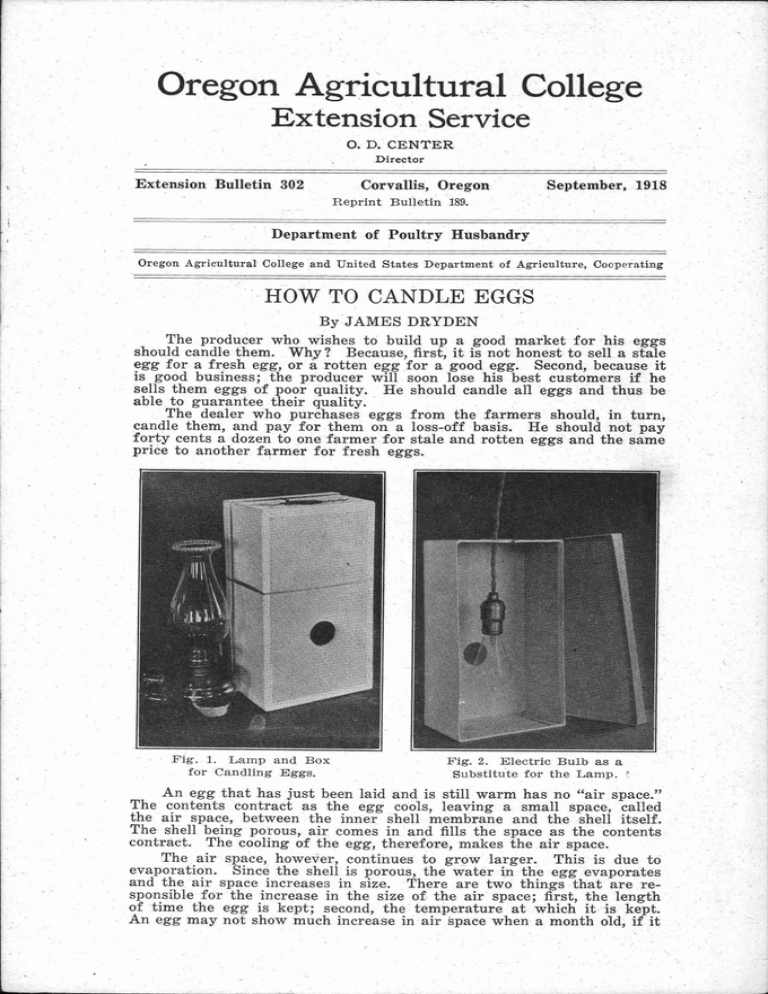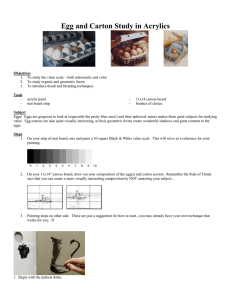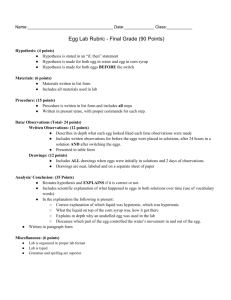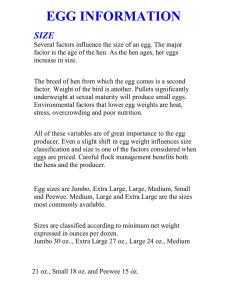Oregon Agricultural College Extension Service HOW TO CANDLE EGGS
advertisement

Oregon Agricultural College Extension Service 0. D. CENTER Director Extension Bulletin 302 Corvallis, Oregon September, 1918 Reprint Bulletin 189. Department of Poultry Husbandry Oregon Agricultural College and United States Department of Agriculture, Cooperating HOW TO CANDLE EGGS By JAMES DRYDEN The producer who wishes to build up a good market for his eggs should candle them. Why? Because, first, it is not honest to sell a stale egg for a fresh egg, or a rotten egg for a good egg. Second, because it is good business; the producer will soon lose his best customers if he sells them eggs of poor quality. He should candle all eggs and thus be able to guarantee their quality. The dealer who purchases eggs from the farmers should, in turn, candle them, and pay for them on a loss-off basis. He should not pay forty cents a dozen to one farmer for stale and rotten eggs and the same price to another farmer for fresh eggs. Fig. 1. Lamp and Box for Candling Eggs, Fig. 2. Electric Bulb as a Substitute for the Lamp. An egg that has just been laid and is still warm has no "air space." The contents contract as the egg cools, leaving a small space, called the air space, between the inner shell membrane and the shell itself. The shell being porous, air comes in and fills the space as the contents contract. The cooling of the egg, therefore, makes the air space. The air space, however, continues to grow larger. This is due to evaporation. Since the shell is porous, the water in the egg evaporates and the air space increases in size. There are two things that are responsible for the increase in the size of the air space; first, the length of time the egg is kept; second, the temperature at which it is kept. An egg may not show much increase in air space when a month old, if it is kept in a cool place. When two weeks old it may show a larger air space if kept in a warm place than if kept a month in a cool place. Evaporation increases as the temperature rises. A large air space means a stale egg. The way to discover the stale egg is to candle it. Take a shoe box; set a lamp or candle in it; light the wick and put the lid on. Cut a hole the size of a small egg in the box opposite the light, and in a dark room hold the egg up to the hole. The air space will be clearly visible. You can tell its freshness without the date mark on it. A suitable box and lamp, ready for use, are shown in Figure 1. In place of a kerosene lamp or tallow candle an electric bulb may be used, as shown in Figure 2. Most any kind of a box will do, one that will fit around the bulba shoe box or cereal box. With the use of this device a fresh-laid egg will look like that in Figure 3. A very stale egg is shown in Figure 4. An egg may pass as fresh though the air space is a trifle larger than that shown in Figure 3. Another thing about the stale egg, the yolk is likely to be found close to the shell at one side, or sticking to it. If such an egg be turned around before the candle, it will show darker on one side than the other, as in Figure 4. That means that the yolk is close to the shell or adhering to it. Fig. 3. Fresh Egg. Note the small air space. Fig. 4. Stale Egg. A large air space. The yolk has also settled to one side of the egg. Other kinds of eggs, some of them more objectionable than stale eggs, can be detected by candling The "rots", for instance, are eggs absolutely unfit for food. Black rots are easily recognized by a blackish appearance caused by the formation of a gas in the egg, which sometimes causes it to explode. The white-rot eggs are watery, with yolk and white mixed, and have an offensive sour mell. Candling will expose them, and it will also show the blood clots in the eggs, and the mold growth adhering to the inside of the shell. There are many different kinds of eggs, and candling is a simple and accurate test as to their quality. The producer should candle the eggs he sells if he wishes to build up and retain a good market. The consumer should candle the eggs he buys to make sure that he is getting what he pays for. Candling Now Required.--In order to stop traffic in bad eggs and to prevent loss of good eggs, regulations have recently been issued by the U. S. Food Administration requiring the candling of eggs. Copies of these regulations may be obtained from the Offices of the State Food Administration and Dairy and Food Commissioner, Portland, or from the Oregon Agricultural College, Corvallis. BANISH BAD EGGS! TURN THE LIGHT ON THEM!






